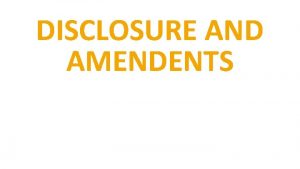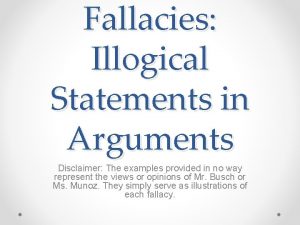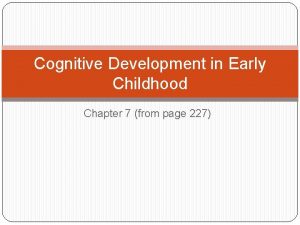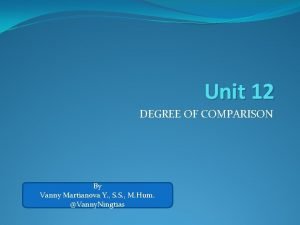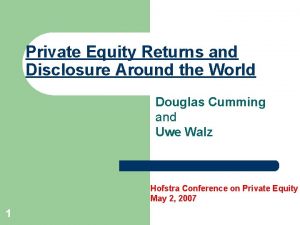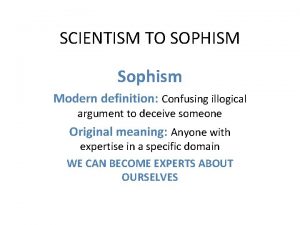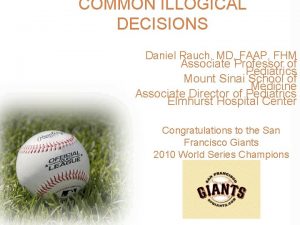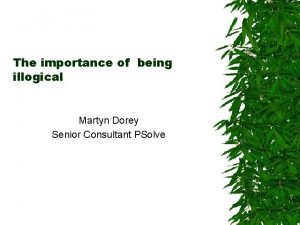DISCLOSURE AND AMENDENTS THE ILLOGICAL LOGIC OF THE













- Slides: 13

DISCLOSURE AND AMENDENTS THE ILLOGICAL LOGIC OF THE EPO

AMENDMENTS – ARTICLE 123(2) EPC Article 123(2) EPC The European patent application or European patent may not be amended in such a way that it contains subject-matter which extends beyond the content of the application as filed (= no new matter) Rule 137(4) EPC When filing any amendments …, the applicant shall … indicate the basis for them in the application as filed. 2 © Zacco 2017

THE “GOLD STANDARD” FOR DISCLOSURE • Very strict standard: Is the claimed subject matter directly and unambiguously derivable from the application as filed? • Photographical approach: Basically requiring literal support for the claimed subject matter/ amendment • The pitfalls of EPO practice: Literal support does not always mean that subject matter is directly and unambiguously disclosed 3 © Zacco 2017

COMBINATION OF FEATURES • Content of an application is not a “reservoir” from which individual features pertaining to separate aspects or embodiments can be combined in order to artificially create a particular combination • A combined selection of features requires a clear and unambiguous pointer towards such combination (“preferred” features may be a pointer) • Best: Provide literal disclosure of individual features and combinations thereof for each separate aspect or embodiment 4 © Zacco 2017

THE “TWO-LIST” PRINCIPLE • Feature combination result of a selection of elements or deletion of elements from two or more lists of a certain length (minimum two elements) Variant 3 Variant 2 Variant 1 5 © Zacco 2017 List 1 List 2 A B C D 1 2 3 4

THE “TWO-LIST” PRINCIPLE • Examples of such selection : (a) Chemical compound(s) from a generic formula whereby the compound(s) selected results from the selection or deletion of specific substituents from two or more "lists" of substituents (b) Mixture(s) resulting from the selection or deletion of individual components from lists of components • (c) Starting materials for the manufacture of a final product 6 © Zacco 2017

THE “TWO-LIST” PRINCIPLE • New matter: If the claimed subject matter is a result in a singling out of a specific combination of elements • No new matter: If the claimed subject matter remains as a generic group differing from the original group only by its smaller size (shrinking of a generic group) 7 © Zacco 2017

THE “TWO-LIST” PRINCIPLE Variant 3 Variant 2 Variant 1 List 2 List 1 List 2 A B C D 1 2 3 4 allowable unallowable • Best: Provide literal disclosure of specific combinations 8 © Zacco 2017

RANGES, SUBRANGES AND VALUES • A range only discloses the end points in a direct an unambiguous manner, but not all subranges and values within • A general statement that all subranges and values are included may not be deemed sufficient • Best: Provide literal disclosure of (preferred) subranges and values 9 © Zacco 2017

COMBINATION OF END POINTS • Combination of end points in case of a disclosed general range and an disclosed narrower subrange possible, however: • New matter: Combining the lower or upper limit of the general range with the respective lower or upper limit of the narrower range • No new matter: Combining the lower limit of the general range and the upper limit of the narrower range, and vice versa 10 © Zacco 2017

INTERMEDIATE GENERALIZATION • Limiting a claim by introducing a specific feature taken in isolation from an originally disclosed combination of features • Only allowable if there is no structural or functional relationship • The isolated feature should have its own recognisable function independent from the function of the other features 11 © Zacco 2017

ADVICE ON DRAFTING • Provide literal disclosure for each feature in an individualized (stand alone) manner, both generic and specific • Do not rely on lists as sole disclosure (“two-list” problematic): Provide literal disclosure for all feature combinations in an individualized (stand alone) manner, or at least of the most relevant/ preferred combinations • Make use of multiple claim dependencies (allowable in EP), such as in the form of a mock claim set (set of items) in the “summary of invention” part – an easy way to create disclosure 12 © Zacco 2017

THANK YOU FOR YOUR ATTENTION Dr. Carsten Prusko / Dr. Hajo Peters cpu@zacco. com / hpe@zacco. com 13 © Zacco 2017
 What's
What's Illogical argument examples
Illogical argument examples Preschoolers seem to use illogical reasoning
Preschoolers seem to use illogical reasoning Adjectives er/more the eat/the most
Adjectives er/more the eat/the most First order logic vs propositional logic
First order logic vs propositional logic First order logic vs propositional logic
First order logic vs propositional logic Third order logic
Third order logic Combinational logic circuit vs sequential
Combinational logic circuit vs sequential Tw
Tw 캠블리 단점
캠블리 단점 Combinational logic sequential logic
Combinational logic sequential logic Combinational logic sequential logic 차이
Combinational logic sequential logic 차이 Combinational logic sequential logic
Combinational logic sequential logic Private equity returns and disclosure around the world
Private equity returns and disclosure around the world
